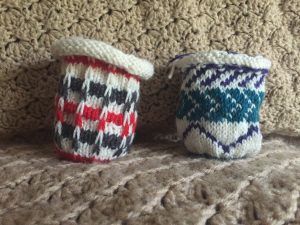Because this basketry was developed by Native American tribes and carries symbolic and spiritual meaning, I decided to use designs elements like color and design to create a knitted tribute to them rather than using native techniques and symbolic images in my work. In doing so, I created two different miniature knitted bags that represent two separate parts of the country. One is based on the wood splint basketry of the New England Native American tribes in the late 1700s, and the other is based off the Pomo of California and the Skokomish of Washington basketry in the early 1800s.Continue reading
Author Archive: Kelsey (Kelso) Kennedy
Pomo and Skoskomish Basketry
The picture of the women and her baskets is representative of some of the forms of basketry made by Native Americans in the Western part of the country during the early 19th century. Woven basketry was a significant cultural aspect for these tribes. The baskets were almost exclusively made by women. Settlers in California encouraged native women to continue to create woven baskets and those who wanted to increase trade and travel in Alaska often used “exotic” native images to entice travelers. The increased tourist trade caused the natives to change from twined to coiled basketry, and designs became increasingly colorful and complex. Color choice was important to the Pomo of California, who use willow shoots, porcupine quills, feathers, and shells as decoration. Green feathers came from mallards and represent astuteness or discretion; blue jay feathers mean cunning; white meant generosity and riches, and they came from the white kaia. Basket making of the Skokomish tribe from Washington was a spiritual act done by women, associated with the powerful being Crow, whose “baskets turned into shells and the basket designs became the patterns of the shells.” The “V” pattern is called “salmon gills.” Designs were geometric, with lots of horizontal and diagonal lines and zig zags; basket makers later began incorporating animal patterns such as dogs and wolves to suit colonist tastes.
This basket is very different from the red and black wood splint baskets from what is now New England. Scholars disagree about how much wood splint basketry in the area was influenced by colonist interests.
REFERENCES CITED
Crawford, Virginia. “Artistic Basketry of the North American Indian.” The Bulletin of the
Cleveland Museum of Art 73, no. 7 (1986): 278-297.
